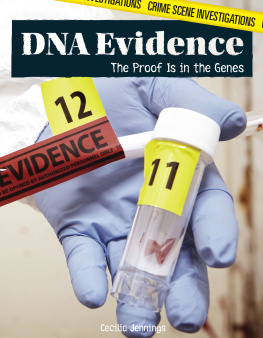Cecilia Jennings - DNA evidence : the proof is in the genes
Here you can read online Cecilia Jennings - DNA evidence : the proof is in the genes full text of the book (entire story) in english for free. Download pdf and epub, get meaning, cover and reviews about this ebook. City: NY, year: 2018, publisher: Lucent Press, genre: Science. Description of the work, (preface) as well as reviews are available. Best literature library LitArk.com created for fans of good reading and offers a wide selection of genres:
Romance novel
Science fiction
Adventure
Detective
Science
History
Home and family
Prose
Art
Politics
Computer
Non-fiction
Religion
Business
Children
Humor
Choose a favorite category and find really read worthwhile books. Enjoy immersion in the world of imagination, feel the emotions of the characters or learn something new for yourself, make an fascinating discovery.
- Book:DNA evidence : the proof is in the genes
- Author:
- Publisher:Lucent Press
- Genre:
- Year:2018
- City:NY
- Rating:5 / 5
- Favourites:Add to favourites
- Your mark:
- 100
- 1
- 2
- 3
- 4
- 5
DNA evidence : the proof is in the genes: summary, description and annotation
We offer to read an annotation, description, summary or preface (depends on what the author of the book "DNA evidence : the proof is in the genes" wrote himself). If you haven't found the necessary information about the book — write in the comments, we will try to find it.
DNA evidence : the proof is in the genes — read online for free the complete book (whole text) full work
Below is the text of the book, divided by pages. System saving the place of the last page read, allows you to conveniently read the book "DNA evidence : the proof is in the genes" online for free, without having to search again every time where you left off. Put a bookmark, and you can go to the page where you finished reading at any time.
Font size:
Interval:
Bookmark:
- Introduction:
Crime Scene Science - Chapter One:
The Early Days of DNA - Chapter Two:
How to Build a DNA Profile - Chapter Three:
A Brief History of DNA Profiling - Chapter Four:
Beyond Crime Scenes - Chapter Five:
A Darker Side of DNA


Published in 2018 by
Lucent Press, an Imprint of Greenhaven Publishing, LLC
353 3rd Avenue Suite 255
New York, NY 10010
Copyright 2018 Greenhaven Press, a part of Gale, Cengage Learning
Gale and Greenhaven Press are registered trademarks used herein under license.
All new materials copyright 2018 Lucent Press, an Imprint of Greenhaven Publishing, LLC.
All rights reserved. No part of this book may be reproduced in any form without permission in writing from the publisher, except by a reviewer.
Designer: Deanna Paternostro Editor: Jennifer Lombardo
Library of Congress Cataloging-in-Publication Data
Names: Jennings, Cecilia, author.
Title: DNA evidence : the proof is in the genes / Cecilia Jennings.
Description: New York : Lucent Press, [2018] | Series: Crime scene investigations | Includes bibliographical references and index.
Identifiers: LCCN 2017044918| ISBN 9781534561762 (library bound book) | ISBN 9781534562738 (paperback book) | ISBN 9781534561755 (eBook)
Subjects: LCSH: DNA fingerprinting. | DNA-Analysis. | Forensic genetics-Technique. | Evidence, Criminal.
Classification: LCC RA1057.55 .J46 2018 | DDC 614/.1-dc23 LC record available at https://lccn.loc.gov/2017044918
Printed in the United States of America
CPSIA compliance information: Batch #CW18KL: For further information contact Greenhaven Publishing LLC, New York, New York at 1-844-317-7404.
Please visit our website, www.greenhavenpublishing.com . For a free color catalog of all our high-quality books, call toll free 1-844-317-7404 or fax 1-844-317-7405.
Introduction:
Crime Scene Science
Chapter One:
The Early Days of DNA
Chapter Two:
How to Build a DNA Profile
Chapter Three:
A Brief History of DNA Profiling
Chapter Four:
Beyond Crime Scenes
Chapter Five:
A Darker Side of DNA
Foreword
F or decades, popular television programs and movies have depicted the life and work of police officers, detectives, and crime scene investigators. Many of these shows and films portray forensic scientists as the brains responsible for cracking cases and bringing criminals to justice. Undoubtedly, these crime scene analysts are an important part in the process of crime solving. With modern technology and advances in forensic analysis, these highly trained experts are a crucial component of law enforcement systems all across the world.
Police officers and detectives are also integral members of the law enforcement team. They are the ones who respond to 911 calls about crime, collect physical evidence, and use their high level of training to identify suspects and culprits. They work right alongside forensic investigators to figure out the mysteries behind why a crime is committed, and the entire team cooperates to gather enough evidence to convict someone in a court of law.
Ever since the first laws were recorded, crime scene investigation has been handled in roughly the same way. An authority is informed that a crime has been committed; someone looks around the crime scene and interviews potential witnesses; suspects are identified based on evidence and testimony; and, finally, someone is formally accused of committing a crime. This basic plan is generally effective, and criminals are often caught and brought to justice. Throughout history, however, certain limitations have sometimes prevented authorities from finding out who was responsible for a crime.
There are many reasons why a crime goes unsolved: Maybe a dead body was found too late, evidence was tampered with, or witnesses lied. Sometimes, even the greatest technology of the age is simply not good enough to process and analyze the evidence at a crime scene. In the United States during the 20th century, for example, the person responsible for the infamous Zodiac killings was never found, despite the earnest efforts of hundreds of policemen, detectives, and forensic analysts.
In modern times, science and technology are integral to the investigative process. From DNA analysis to high-definition surveillance video, it has become much more difficult to commit a crime and get away with it. Using advanced computers and immense databases, microscopic skin cells from a crime scene can be collected and then analyzed by a forensic scientist, leading detectives to the home of the culprit of a crime. Dozens of people work behind the scenes of criminal investigations to figure out the unique and complex elements of a crime. Although this process is still time-consuming and complicated, technology is constantly improving and adapting to the needs of police forces worldwide.
This series is designed to help young readers understand the systems in place to allow forensic professionals to do their jobs. Covering a wide range of topics, from the assassination of President John F. Kennedy to 21st-century cybercriminals, these titles describe in detail the ways in which technology and criminal investigations have evolved over more than 50 years. They cite eyewitnesses and experts in order to give a detailed and nuanced picture of the difficult task of rooting out criminals. Although television shows and movies add drama to the crime scene investigation process, these real-life stories have enough drama on their own. This series sticks to the facts surrounding some of the highest-profile criminal cases of the modern era and the people who work to solve them and other crimes every day.

A lthough crime-solving work is a lot more than simply matching suspects to deoxyribonucleic acid (DNA), it is true that DNA can be useful to detectives when they are trying to prove someones involvement in a crime. Because DNA is unique in every individual, it can be thought of as the genetic blueprint of humans and other living thingsindeed, DNA is sometimes referred to as the genetic fingerprint. Just like someones fingerprints can prove that they touched or handled a certain object, DNA can be used to place a suspect at the scene of a crimeor prove they were not there. This process is sometimes called DNA fingerprinting, even though it does not involve actual fingerprints. More commonly, it is called DNA analysis.
Modern television crime dramas have helped make the public aware that DNA analysis is part of a special branch of science called forensic science, often simply called forensics. Forensics applies scientific methods to legal matters, particularly to solving crimes. DNA is not the only form of evidence used in the fascinating world of forensic science. The forensic experts depicted on CSI: Crime Scene Investigation,often referred to as just CSI, and other shows regularly supplement their DNA analysis by examining finger and palm prints, shoe and tire tracks, blood types, cloth fibers, and many other kinds of forensic evidence.
The use of DNA analysis as a scientific crime-solving technique became available to law enforcement officials only in the last few decades, as technology evolved to allow investigators to collect and analyze samples left behind at crime scenes. The forensic use of DNA is the result of a long, winding, often uneven history of scientific crime solving. Like all areas of scientific inquiry, DNAs use in criminal investigations would not have happened without many years of study. In fact, widespread understanding of forensic methods did not exist until about a century ago. However, police and other investigators have attempted to solve crimes throughout recorded human history, and basic scientific tech-niquesalthough not yet called science or forensicswere introduced into the process a little at a time over the centuries.
Next pageFont size:
Interval:
Bookmark:
Similar books «DNA evidence : the proof is in the genes»
Look at similar books to DNA evidence : the proof is in the genes. We have selected literature similar in name and meaning in the hope of providing readers with more options to find new, interesting, not yet read works.
Discussion, reviews of the book DNA evidence : the proof is in the genes and just readers' own opinions. Leave your comments, write what you think about the work, its meaning or the main characters. Specify what exactly you liked and what you didn't like, and why you think so.












